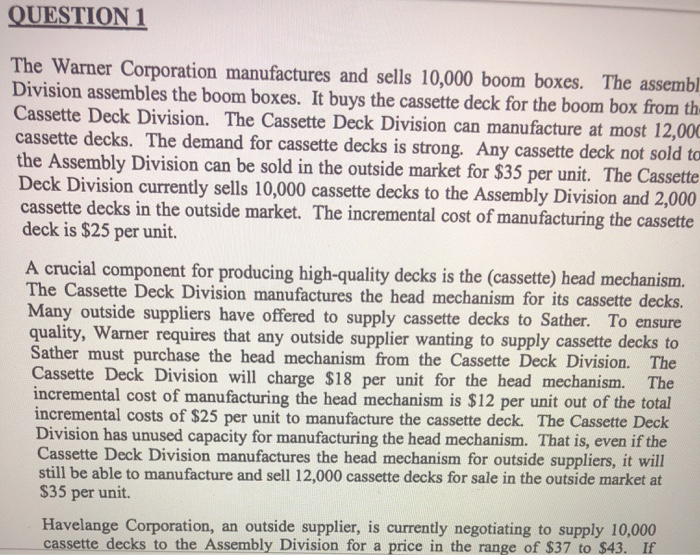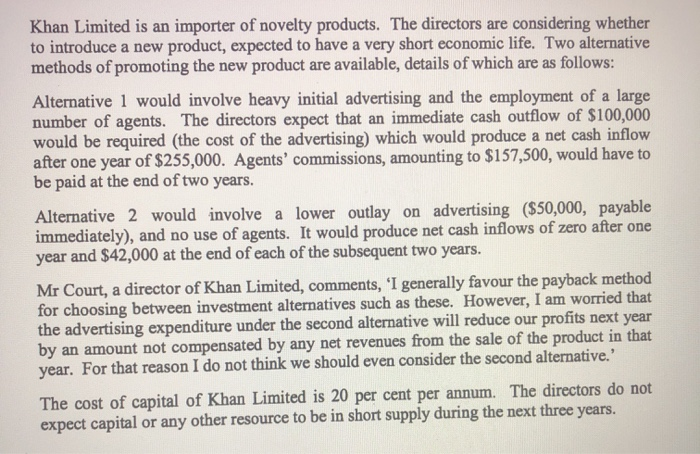QUESTION 1 The Warner Corporation manufactures and sells 10,000 boom boxes. The assembl Division assembles the boom boxes. It buys the cassette deck for the boom box from th Cassette Deck Division. The Cassette Deck Division can manufacture at most 12,004 cassette decks. The demand for cassette decks is strong. Any cassette deck not sold to the Assembly Division can be sold in the outside market for $35 per unit. The Cassette Deck Division currently sells 10,000 cassette decks to the Assembly Division and 2,000 cassette decks in the outside market. The incremental cost of manufacturing the cassette deck is $25 per unit. A crucial component for producing high-quality decks is the (cassette) head mechanism. The Cassette Deck Division manufactures the head mechanism for its cassette decks. Many outside suppliers have offered to supply cassette decks to Sather. To ensure quality, Warner requires that any outside supplier wanting to supply cassette decks to Sather must purchase the head mechanism from the Cassette Deck Division. The Cassette Deck Division will charge $18 per unit for the head mechanism. The incremental cost of manufacturing the head mechanism is $12 per unit out of the total incremental costs of $25 per unit to manufacture the cassette deck. The Cassette Deck Division has unused capacity for manufacturing the head mechanism. That is, even if the Cassette Deck Division manufactures the head mechanism for outside suppliers, it will still be able to manufacture and sell 12,000 cassette decks for sale in the outside market at $35 per unit. Havelange Corporation, an outside supplier, is currently negotiating to supply 10,000 cassette decks to the Assembly Division for a price in the range of $37 to $43. If Khan Limited is an importer of novelty products. The directors are considering whether to introduce a new product, expected to have a very short economic life. Two alternative methods of promoting the new product are available, details of which are as follows: Alternative 1 would involve heavy initial advertising and the employment of a large number of agents. The directors expect that an immediate cash outflow of $100,000 would be required (the cost of the advertising) which would produce a net cash inflow after one year of $255,000. Agents' commissions, amounting to $157,500, would have to be paid at the end of two years. Alternative 2 would involve a lower outlay on advertising ($50,000, payable immediately), and no use of agents. It would produce net cash inflows of zero after one year and $42,000 at the end of each of the subsequent two years. Mr Court, a director of Khan Limited, comments, 'I generally favour the payback method for choosing between investment alternatives such as these. However, I am worried that the advertising expenditure under the second alternative will reduce our profits next year by an amount not compensated by any net revenues from the sale of the product in that year. For that reason I do not think we should even consider the second alternative.' The cost of capital of Khan Limited is 20 per cent per annum. The directors do not expect capital or any other resource to be in short supply during the next three years. QUESTION 1 The Warner Corporation manufactures and sells 10,000 boom boxes. The assembl Division assembles the boom boxes. It buys the cassette deck for the boom box from th Cassette Deck Division. The Cassette Deck Division can manufacture at most 12,004 cassette decks. The demand for cassette decks is strong. Any cassette deck not sold to the Assembly Division can be sold in the outside market for $35 per unit. The Cassette Deck Division currently sells 10,000 cassette decks to the Assembly Division and 2,000 cassette decks in the outside market. The incremental cost of manufacturing the cassette deck is $25 per unit. A crucial component for producing high-quality decks is the (cassette) head mechanism. The Cassette Deck Division manufactures the head mechanism for its cassette decks. Many outside suppliers have offered to supply cassette decks to Sather. To ensure quality, Warner requires that any outside supplier wanting to supply cassette decks to Sather must purchase the head mechanism from the Cassette Deck Division. The Cassette Deck Division will charge $18 per unit for the head mechanism. The incremental cost of manufacturing the head mechanism is $12 per unit out of the total incremental costs of $25 per unit to manufacture the cassette deck. The Cassette Deck Division has unused capacity for manufacturing the head mechanism. That is, even if the Cassette Deck Division manufactures the head mechanism for outside suppliers, it will still be able to manufacture and sell 12,000 cassette decks for sale in the outside market at $35 per unit. Havelange Corporation, an outside supplier, is currently negotiating to supply 10,000 cassette decks to the Assembly Division for a price in the range of $37 to $43. If Khan Limited is an importer of novelty products. The directors are considering whether to introduce a new product, expected to have a very short economic life. Two alternative methods of promoting the new product are available, details of which are as follows: Alternative 1 would involve heavy initial advertising and the employment of a large number of agents. The directors expect that an immediate cash outflow of $100,000 would be required (the cost of the advertising) which would produce a net cash inflow after one year of $255,000. Agents' commissions, amounting to $157,500, would have to be paid at the end of two years. Alternative 2 would involve a lower outlay on advertising ($50,000, payable immediately), and no use of agents. It would produce net cash inflows of zero after one year and $42,000 at the end of each of the subsequent two years. Mr Court, a director of Khan Limited, comments, 'I generally favour the payback method for choosing between investment alternatives such as these. However, I am worried that the advertising expenditure under the second alternative will reduce our profits next year by an amount not compensated by any net revenues from the sale of the product in that year. For that reason I do not think we should even consider the second alternative.' The cost of capital of Khan Limited is 20 per cent per annum. The directors do not expect capital or any other resource to be in short supply during the next three years








